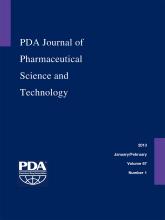Case ReportCase Studies
Identification and Root Cause Analysis of Cell Culture Media Precipitates in the Viral Deactivation Treatment with High-Temperature/Short-Time Method
Xiaolin Cao, Gregory Stimpfl, Zai-qing Wen, Gregory Frank and Glenn Hunter
PDA Journal of Pharmaceutical Science and Technology January 2013, 67 (1) 63-73; DOI: https://doi.org/10.5731/pdajpst.2013.00894
Xiaolin Cao
1Department of Drug Product Development, Amgen Inc., Thousand Oaks, CA 91320 and
Gregory Stimpfl
2Department of Pilot Plant Operations, Amgen Inc., Thousand Oaks, CA 91320
Zai-qing Wen
1Department of Drug Product Development, Amgen Inc., Thousand Oaks, CA 91320 and
Gregory Frank
2Department of Pilot Plant Operations, Amgen Inc., Thousand Oaks, CA 91320
Glenn Hunter
2Department of Pilot Plant Operations, Amgen Inc., Thousand Oaks, CA 91320

References
- 1.↵
- Kerr A.,
- Nims R
- 2.↵
- Weaver B.,
- Rosenthal S
- 3.↵
- 4.↵
- 5.↵
- 6.↵
- 7.↵
- Wen Z.-Q.,
- Cao X.,
- Phillips J
- 8.↵
- Pinzaru S. C.,
- Pavel I.,
- Leopold N.,
- Kiefer W
- 9.↵
- Winefordner J. D.
- McCreery L. R
- 10.↵
- 11.↵
- Kodati V. R.,
- Tomasi G. E.,
- Turumin Y. L.,
- Tu A. T
- 12.↵
- Yin X.,
- Stott M. J.,
- Rubio A
- 13.↵
- 14.↵
- Grandi G.,
- Heitz C.,
- Alberto dos Santos L.,
- Silva M. L.,
- Sant'Ana Filho M.,
- Pagnocelli R. M.,
- Silva D. N
- 15.↵
- Rojbani H.,
- Nyan M.,
- Ohya K.,
- Kasugai S
- 16.↵
Wikipedia. TCP standard enthalpy of formation. http://en.wikipedia.org/wiki/Tricalcium_phosphate 2011.
- 17.↵
- Haynes W. M
- 18.↵
- Oliver S
- 19.↵
Wikipedia. Calcium phosphate uncommon solubility-temperature dependence. http://en.wikipedia.org/wiki/calcium_phosphate.
In This Issue
PDA Journal of Pharmaceutical Science and Technology
Vol. 67, Issue 1
January/February 2013
Identification and Root Cause Analysis of Cell Culture Media Precipitates in the Viral Deactivation Treatment with High-Temperature/Short-Time Method
Xiaolin Cao, Gregory Stimpfl, Zai-qing Wen, Gregory Frank, Glenn Hunter
PDA Journal of Pharmaceutical Science and Technology Jan 2013, 67 (1) 63-73; DOI: 10.5731/pdajpst.2013.00894
Identification and Root Cause Analysis of Cell Culture Media Precipitates in the Viral Deactivation Treatment with High-Temperature/Short-Time Method
Xiaolin Cao, Gregory Stimpfl, Zai-qing Wen, Gregory Frank, Glenn Hunter
PDA Journal of Pharmaceutical Science and Technology Jan 2013, 67 (1) 63-73; DOI: 10.5731/pdajpst.2013.00894
Jump to section
Related Articles
- No related articles found.





